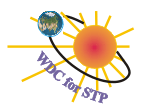|
|
|
AU, AL, AE, AО Indices of Geomagnetic Activity
AE, AU, AL, AО indices of geomagnetic activity characterize the magnetic disturbance in the auroral zone
due to the increase in currents in the ionosphere along the boundary of the auroral oval (the eastern and western currents
of the polar electrojet).
The method of calculating the AU, AL, AE, AO indices is based on determining the magnitude of the deviation
of the horizontal H component of the geomagnetic field from a quiet level - the average monthly value H
calculated according to five international quiet days. To calculate AU, AL, AE, AO indices, the geomagnetic data
of 12 observatories located at auroral or subauroral latitudes and uniformly distributed over the longitude are used:
Abisko, Dixon Island, Cape Chelyuskin, Tixie Bay, Pebek, Barrow, College, Yellowknife, Fort Churchill, Sanikiluaq, Narssarssuaq, and Leirvogur.
AU index (auroral upper) corresponds to the maximum positive deviation of H component of the magnetic
field from the average quiet level for all observatories of the auroral zone.
AL index (auroral low) corresponds to the maximum negative deviation of H component of the magnetic
field from the average quiet level for all observatories of the auroral zone.
AЕ index was proposed by Davis and Sugiura [1966]. It is defined as the sum of the absolute values of the
AU and AL indices, i.e. the total
magnitude of the magnetic fluctuations in the H component of the geomagnetic field. The index AЕ characterizes
magnetic perturbation in the zone as a whole, irrespective of the place of appearance of the perturbation.
The value (AU+AL)/2 was defined as the AO index and it geometrically represents the moving midpoint
between AU and AL values at any given time.
The AE, AU, AL, AO indices are calculated and published by the
World Data Center for Geomagnetism, Kyoto.
Citation: World Data Center for Geomagnetism, Kyoto, Nose M., Iyemori T., Sugiura M. and Kamei T. (2015) -
Geomagnetic АЕ index, doi:10.17593/15031-54800
WDC for STP Moscow is grateful to the International Service of Geomagnetic Indices for the provision of data
on the hourly АЕ index values in the IAGA2002 format for 1957-1975 time period
doi:10.17616/R3WS49
and to the INTERMAGNET network doi:10.17616/R3XK82
Using the data, please be sure to indicate the above organizations according to the following
template.
Hourly values of the AE index for the period 1957-1965 in
WDC format.
Hourly values of the AE index for the period 1957-1965
in IAGA2002 format.
Hourly values of the AE, AU, AL, AО indices
from 1966 to the present in WDC format
(data for 1976 and 1977 are absent).
Hourly values of the AE, AU, AL, AО indices
from 1966 to the present in IAGA2002 format
(data for 1976 and 1977 are absent).
Minute values of the AE, AU, AL, AО indices
from 1974 г. to the present
in WDC format
(data for VII.1988-II.1989 and IV-XII.1989 are absent).
Minute values of the AE, AU, AL, AО indices
from 1974 г. to the present
in IAGA2002 format
(data for VII.1988-II.1989 and IV-XII.1989 are absent).
Acknowledgements: Please cite with doi when and where appropriate. Also please acknowledge
the geomagnetic observatories (Abisko, Dixon Island, Cape Chelyuskin, Tixie Bay, Pebek, Barrow, College, Yellowknife,
Fort Churchill, Sanikiluaq, Narssarssuaq, and Leirvogur).
How to Cite Datasets: http://www.dcc.ac.uk/resources/how-guides/cite-datasets
Ball, A. and M. Duke [2011], How to cite datasets and link to publications, DCC How-to Guides, Edinburgh: Digital Curation Centre.
Reference: Davis, T. N., and M. Sugiura (1966) - Auroral electroject activity index AE and its universal time variations,
J. Geophys. Res., 71, 785-801, doi:10.1029/JZ071i003p00785.
|
|
|



